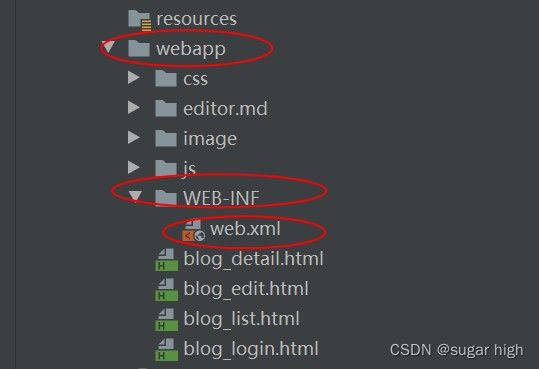博客系统项目详解
项目类型:Java Web项目
主要技术:Html、CSS、JS、Servlet、MySQL
开发工具:IDEA
数据库:MySQL
数据库表:2张
项目介绍:使用约定前后端接口,前后端分离的方法。后端采用Servlet,前端使用的是Html、CSS、JS。基本的功能包括用户登录、显示用户信息 、博客的编辑与发布、删除博客和用户注销功能。判定用户状态限制用户可操作的功能。
github链接
页面展示
- 1.创建maven项目
- 2.导入写好的前端代码
- 3.设计数据库
- 4.封装数据库操作
-
- 1)创建 DBUtil 类
- 2)创建 Blog类
- 3)创建 User
- 4 )创建BlogDao类
- 5)创建UserDao类
- 5.实现博客主界面
-
- 1)约定前后端交互接口
- 2)编写服务器代码
- 3)编写客户端代码
- 6.实现博客详细界面
-
- 1)约定前后端交互接口
- 2)编写服务器代码
- 3)编写客户端代码
- 7.实现博客登陆页面
-
- 1)约定前后端交互接口
- 2)编写服务器代码
- 3)编写客户端代码
- 8.实现用户状态判定功能
-
- 1)约定前后端交互接口
- 2)编写服务器代码
- 3)common.js逻辑实现部分
- 9.实现显示用户信息功能
-
- 1)约定前后端交互接口
- 2)编写服务器代码
- 3)blog_detail逻辑实现部分
- 10.实现注销功能
-
- 1)约定前后端交互接口
- 2)编写服务器代码
- 3)编写客户端代码
- 11.实现发布博客功能
-
- 1)约定前后端交互接口
- 2)编写服务器代码
- 3)编写客户端代码
- 12.实现删除博客功能
-
- 1)约定前后端交互接口
- 2)编写服务器代码
- 3)编写客户端代码
1.创建maven项目
1.创建maven项目并创建好所需要的webapp目录

2.在web.xml引入代码片段
<!DOCTYPE web-app PUBLIC
"-//Sun Microsystems, Inc.//DTD Web Application 2.3//EN"
"http://java.sun.com/dtd/web-app_2_3.dtd" >
<web-app>
<display-name>Archetype Created Web Application</display-name>
</web-app>
3.引入依赖(pom.xml)
<dependencies>
<!-- https://mvnrepository.com/artifact/javax.servlet/javax.servlet-api -->
<dependency>
<groupId>javax.servlet</groupId>
<artifactId>javax.servlet-api</artifactId>
<version>3.1.0</version>
<scope>provided</scope>
</dependency>
<!-- https://mvnrepository.com/artifact/com.fasterxml.jackson.core/jackson-databind -->
<dependency>
<groupId>com.fasterxml.jackson.core</groupId>
<artifactId>jackson-databind</artifactId>
<version>2.12.6.1</version>
</dependency>
<!-- 引入 mysql 驱动包 -->
<!-- https://mvnrepository.com/artifact/mysql/mysql-connector-java -->
<dependency>
<groupId>mysql</groupId>
<artifactId>mysql-connector-java</artifactId>
<version>5.1.47</version>
</dependency>
</dependencies>
<packaging>war</packaging>
<build>
<finalName>blog_sys</finalName>
</build>
2.导入写好的前端代码
3.设计数据库
本系统的两个实体信息包括用户和博客,因此创建用户表和博客表。
创建用户表:
用户id ,用户名,用户密码
创建博客表:
博客的 id,博客的标题,博客的内容,博客的日期,作者 id
db.sql
-- 编写建库建表的 sql
create database if not exists blog_sys;
use blog_sys;
-- 创建一个博客表
drop table if exists blog;
create table blog (
blogId int primary key auto_increment,
title varchar(1024),
content mediumtext,
userId int,
postTime datetime
);
-- 给博客表插入数据,方便测试
insert into blog values(null, '这是第一篇博客', '从今天开始,我要认真学java', 1, now());
insert into blog values(null, '这是第二篇博客', '从今天开始,我要认真学java', 1, now());
insert into blog values(null, '这是第三篇博客', '从今天开始,我要认真学java', 1, now());
insert into blog values(null, '这是第一篇博客', '从今天开始,我要认真学java', 2, now());
insert into blog values(null, '这是第二篇博客', '从今天开始,我要认真学java', 2, now());
insert into blog values(null, '这是第三篇博客', '从今天开始,我要认真学java', 2, now());
insert into blog values(null, '这是第四篇博客', '从今天开始,我要认真学java', 2, now());
-- 创建一个用户表
drop table if exists user;
create table user(
userId int primary key auto_increment,
username varchar(128) unique,
password varchar(128)
);
insert into user values(null, 'zhangsan', '123');
insert into user values(null, 'lisi', '123');
4.封装数据库操作
1)创建 DBUtil 类
用于和数据库建立连接
public class DBUtil {
private static final String URL = "jdbc:mysql://127.0.0.1:3306/blog_sys?characterEncoding=utf8&useSSL=false";
private static final String USERNAME = "root";
private static final String PASSWORD = "";
private static volatile DataSource dataSource = null;
private static DataSource getDataSource(){
if(dataSource == null){
synchronized (DBUtil.class){
if(dataSource == null){
dataSource = new MysqlDataSource();
( (MysqlDataSource)dataSource).setURL(URL);
((MysqlDataSource)dataSource).setUser(USERNAME);
((MysqlDataSource)dataSource).setPassword(PASSWORD);
}
}
}
return dataSource;
}
public static Connection getConnection() throws SQLException {
return getDataSource().getConnection();
}
public static void close(Connection connection, PreparedStatement statement, ResultSet resultSet){
if(resultSet != null){
try {
resultSet.close();
} catch (SQLException throwables) {
throwables.printStackTrace();
}
}
if(statement != null){
try {
statement.close();
} catch (SQLException throwables) {
throwables.printStackTrace();
}
}
if(connection != null){
try {
connection.close();
} catch (SQLException throwables) {
throwables.printStackTrace();
}
}
}
}
2)创建 Blog类
博客信息和获取、设置博客信息方法的抽象类
public class Blog {
private int blogId;
private String title;
private String content;
private int userId;
private Timestamp postTime;
public int getBlogId() {
return blogId;
}
public void setBlogId(int blogId) {
this.blogId = blogId;
}
public String getTitle() {
return title;
}
public void setTitle(String title) {
this.title = title;
}
public String getContent() {
return content;
}
public void setContent(String content) {
this.content = content;
}
public int getUserId() {
return userId;
}
public void setUserId(int userId) {
this.userId = userId;
}
//把这里的getter方法给改了,不是返回一个时间戳对象,而是返回一个String(格式化好的时间)
public String getPostTime() {
//使用SimpleDateFormat来完成时间戳到格式化日期时间的转换
//这个转换过程,需要在构造方法中指定要转换的格式,然后调用format来进行转换
SimpleDateFormat simpleDateFormat = new SimpleDateFormat("yyyy-MM-dd HH:mm:ss");
return simpleDateFormat.format(postTime);
}
public void setPostTime(Timestamp postTime) {
this.postTime = postTime;
}
}
3)创建 User
用户信息和获取、设置用户信息方法的抽象类
public class User {
private int userId = 0;
private String username = "";
private String password = "";
public int getUserId() {
return userId;
}
public void setUserId(int userId) {
this.userId = userId;
}
public String getUsername() {
return username;
}
public void setUsername(String username) {
this.username = username;
}
public String getPassword() {
return password;
}
public void setPassword(




